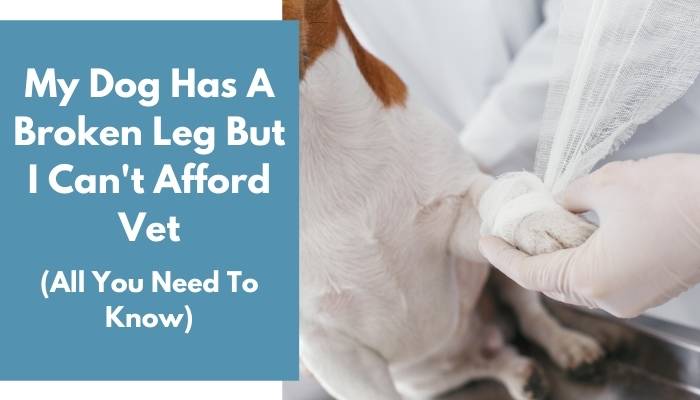Going to a veterinary clinic is the best option for your pet’s emergencies and special care. Since Vet treatment can sometimes be quite expensive, pet owners are forced to hold off treatment.
My dog has a broken leg but I can’t afford Vet – what to do? You may raise a fund to shoulder the costs of your dog’s broken leg treatment. To do that, there are ways that can help you, such as pet insurance, credit line, crowdfunding, or look for other payment options.
Of all dog’s injuries, having a fractured leg is the most common. A dog’s broken leg can be due to a hard fall or vehicular accident.
This article will let you know what you need to do to fix your dog’s injured legs. It will also tackle when to see a vet, the difference between sprained and a broken leg, and the average cost of veterinary clinics.
Contents
- 1 What Do I Do If I Can’t Afford To Take My Dog To The Vet With A Broken Leg?
- 2 How Do You Fix A Dog’s Broken Leg?
- 3 Can A Dog’s Broken Leg Heal On Its Own Without Surgery?
- 4 How Much Is A Vet Bill For A Dog’s Broken Leg?
- 5 How Do I Know If My Dog’s Leg Injury Is Serious?
- 6 How Can I Tell If My Dog’s Leg Is Broken Or Just Sprained?
- 7 Can A Broken Leg Kill A Dog?
- 8 Summary
- 9 Resources
What Do I Do If I Can’t Afford To Take My Dog To The Vet With A Broken Leg?
Every dog deserves proper medical and health care. It can sometimes be a bit expensive but having veterinary care is vital to achieving good health.
There’s no such expensive price when it comes to your canine companion. However, there are times in which you cannot afford to see a Veterinarian.
However, there are possible ways to help you afford an amount to take them to the Vet.
There are few creative and effective ways to save money and help you reduce veterinary costs in times of emergency.
1. Pet Insurance
This method will help you provide financial resources in the event of an emergency.
It can take off the burden on your shoulders in paying veterinary bills. There are also various types of pet insurance. If you consider applying for this, make sure to consider its monthly premiums, deductible amounts, payout maximum, add-on options, etc.
It works differently from human medical insurance. Here, you will be paying on the spot the total amount and then get reimbursed after submitting your claim.
2. Credit Line
You can opt to get an online credit provider such as care credit, scratch play, etc. It finances veterinary medical expenses and pet emergencies aside from health and beauty aspects.
It offers you flexible terms of repeatedly using your card for your pet’s procedures.
3. Crowdfunding
Nowadays, social media influence is rampant. Thus, you may consider raising funds for your dog’s veterinary bills or treatment.
There are many available sites where you can reach your family, friends, and an even broader scope of people.
Besides, you can also use social media to look for nonprofit foundations online at the same time. They may help you provide emergency assistance for pets with critical needs.
4. Other Payment Options
It may sound impossible, but you may ask for payment options for some veterinary clinics if you are desperate enough. A few may allow you to pay the bills monthly or, depending on your agreement with the clinic.
If you can’t find payment options that will suit your situation now, then you may avail of some low-cost clinics. It might not be that ideal because they may lack facilities that will cater to your injured dog’s needs.
5. Ask Help From Family And Friends
Asking for help from your significant others could either be your first option or last resort after exhausting all means. You could try reaching out to your family, friends, members of your community organization, church, etc.
It may sound a desperate move, but they might extend help for your beloved pet.
How Do You Fix A Dog’s Broken Leg?
Like any other pets and even humans, bones are subject to breakage. If your dog has a broken leg, the best thing to do immediately is to apply first-aid.
Here’s a step-by-step guide to treat your dog’s broken leg.
- Approach your dog slowly and carefully.
- Kindly move your pet to a safer place before you administer first-aid.
- Evaluate your dog’s condition and assess how the dog was after breaking its leg.
- A broken leg needs to be immobilized first. It will ease the pain and avoid further damage to its muscles, blood vessel, and nerves.
- In order to immobilize the limb, it can be put into a sling, confine your pet in a small place, and use splints or bandages while waiting for definitive treatment.
- At the Vet, there will be a series of tests and x-ray to determine the severity of the fracture. Some of the treatments that will help fix your dog’s broken legs are external coaptation, external fixation, or internal fixation.
- For an external coaptation, a splint or cast will be applied to the outside limb. It helps resist bending forces as well as resisting torsion and compression forces.
- Another is external fixation, in which a surgically applied device is placed on the bones using pins. It may thread into the bone yet come out through the skin. This process is also best to resist bending, compression, or torsion forces.
- And then, for internal fixation, a surgically applied device will be implanted inside your dog’s bone or within the surface of the bone only.
- Fixing your dog’s fracture continues until aftercare. At home, keep monitoring the bandage if it slips or gets damage.
- Please keep your dog confined and restrict its activity for faster recovery.
- To completely heal its leg, always assist your dog and improve its leg use through physical therapy. Cold and massage therapy will also help.

Can A Dog’s Broken Leg Heal On Its Own Without Surgery?
Usually, canine fractures heal at least four weeks for younger dogs, while it might take at least eight weeks for older ones.
Healing your dog’s broken leg without surgery is possible. Fractures that can heal independently using a non-surgical method are applicable for simple close fractures or other minor breaks.
Non-surgical methods include conservative management and external coaptation.
For conservative management, it includes cage rest or lead exercise. It provides enough stability to keep the bones aligned while healing takes place.
On the other hand, external coaptation uses a splint, bandage, or sling cast. This method aims to transmit compressive forces from the bandage to the bones through interposed soft tissues.
These non-surgical methods reduce the need for anesthesia. Thus, it can be economical. However, it won’t apply to some cases because it may complicate the fracture and worsen.
How Much Is A Vet Bill For A Dog’s Broken Leg?
There is no exact amount of vet bill for a dog’s broken leg. It may vary depending on the severity of the fracture.
It can run from $200 up to $2000 and above. It may need a piece of equipment, professional fee, and aftercare requirements if surgery is conducted.
The cost may exceed $2000 and above if multiple bone fractures are within a leg. Veterinary costs may go higher, considering the dog’s age and other medical conditions.
However, for cases that are not severe, you can pay as low as $600 or even lower than that.
Also, veterinary bills depend much on the leg broken, its severity, and the veterinarian’s geographical location.
Aside from that, there are extra costs included in your bill. It consists of the x-ray performed in assessing the bone fracture on your dog’s legs. Another is the medication prescribed to your pet for pain and swelling treatment, which may range from $30 to $50.
How Do I Know If My Dog’s Leg Injury Is Serious?
You need to immediately go to the Vet if your dog shows symptoms of dangling limbs, swelling, hot limbs, limping, noticeable break or a natural angle, etc. These are some of the obvious indications that your dog’s leg injury is serious and calls for an emergency.
However, it is difficult to note if your dog is suffering severe pain if there are no physical manifestations. Most of the time, dogs will suffer in silence.
For you to be aware of its serious injury, there are warning signs of behavioral and emotional changes that may occur aside from its outside appearance.
Observe the changes in its eating, drinking, and sleeping routines. Usually, dogs may tend to sleep more than usual. There is a noticeable loss of appetite too.
Another is that dogs may express antisocial tendencies such as avoiding contact or hiding away. They may also start yelping, growling, snarling as their way of telling you that something is not right.
You could also observe issues in mobility and signs of agitation.
How Can I Tell If My Dog’s Leg Is Broken Or Just Sprained?
A broken or sprained leg’s symptoms are hard to differentiate for it mirrors each other. It can be tricky also if there is no visible injury to the leg.
Basically, a broken leg occurs when there is a physical break within the bone. It could vary from incomplete or complete fracture, transverse, and open or closed fracture.
On the other hand, a sprain is an issue on the soft tissue which occurs when a ligament that connects bone is being damaged. It usually occurs on the joints on the knees or ankles.
Notice if your canine companion cannot put weight on its legs. If so, then there’s a possibility that your dog may have a broken leg.
But, if your pet can still walk and place a weight on its legs, you may wait and observe for a few hours to detect the problem. If it improves, your dog may have experienced a sprained leg.
In order to correctly detect your pet’s leg condition, you may visit a veterinarian. They will conduct a complete visual examination and x-ray on it to accurately diagnose your dog.
Can A Broken Leg Kill A Dog?
A broken leg alone may not be life-threatening for your dog. There are only a few animals who die because of broken legs.
Fractured bones can heal and go back to their normal shape and strength. However, other critical issues may arise caused by severe leg trauma.
This condition can lead to internal bleeding or organ injury. Hence, it can be fatal to dogs that may eventually kill them if things worsen.
Summary
In summary, dogs may accidentally fracture their bones from exercise, play, falling from a height, road accidents, etc. They may easily break their front or back leg because of those reasons.
Sometimes, pet owners do not figure out immediately that their dog is suffering from an injury. Common symptoms exhibited are abnormal limb movement, lameness, swelling limb, etc.
This unexpected critical need may arise in situations where you can’t afford to go to the Vet. When a dog broke its leg, the first thing to do is apply first-aid. There is a need to seek professionals to examine your dog’s condition further.
An injury can sometimes not be easily spotted. There are cases that there are no physical manifestations of a broken leg. It does not mean that your dog is perfectly doing fine because there could be apparent internal issues without your knowledge.
Good thing that this unfortunate reality can be solved by the availability of ways to raise an amount for your pet’s treatment. It’s a suitable cause method.
Bringing them to veterinary clinics gives your canine pet the high quality of service and treatment they deserve.
Nevertheless, exerting your effort for aftercare at home can advance their recovery. Thus, it will keep them healthy and strong while enhancing your bond together.
Resources
Image credits – Canva



